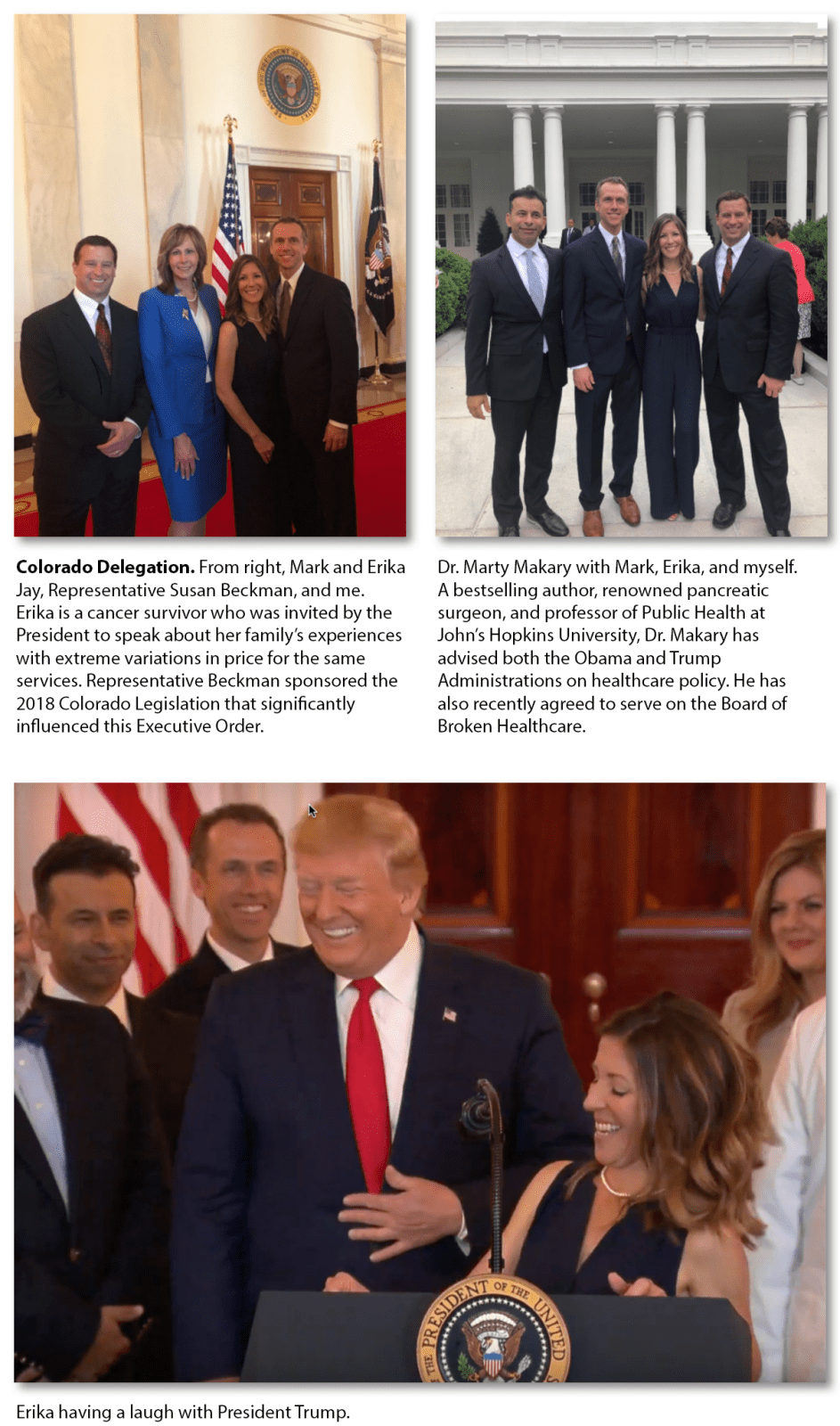I have been contacted by many people asking for a full copy of the Executive Order signed by the President yesterday. You can find that official version below, along with a couple of photos.
The battle ain’t over. What the Executive Order does is direct the Secretaries of Health, Labor and the Treasury to write the detailed rules that will get it done. The value of an Order from the President is just that—it’s an order. It removes much of the pressure to compromise with corrupt actors in the healthcare industry that having been telling the President and Congress lies for years. The President is fed up, as are many members of Congress. The industry has, in many ways, become its own worst enemy. I’ll be staying close to the rule writing in the months to come, doing my best to ensure the rules written are truly effective.


Office of the Press Secretary
FOR IMMEDIATE RELEASE
June 24, 2019
EXECUTIVE ORDER
– – – – – – –
IMPROVING PRICE AND QUALITY TRANSPARENCY IN AMERICAN HEALTHCARE TO PUT PATIENTS FIRST
By the authority vested in me as President by the Constitution and the laws of the United States of America, it is hereby ordered as follows:
Section 1. Purpose. My Administration seeks to enhance the ability of patients to choose the healthcare that is best for them. To make fully informed decisions about their healthcare, patients must know the price and quality of a good or service in advance. With the predominant role that third-party payers and Government programs play in the American healthcare system, however, patients often lack both access to useful price and quality information and the incentives to find low-cost, high-quality care. Opaque pricing structures may benefit powerful special interest groups, such as large hospital systems and insurance companies, but they generally leave patients and taxpayers worse off than would a more transparent system.
Pursuant to Executive Order 13813 of October 12, 2017 (Promoting Healthcare Choice and Competition Across the United States), my Administration issued a report entitled “Reforming America’s Healthcare System Through Choice and Competition.” The report recommends developing price and quality transparency initiatives to ensure that healthcare patients can make well-informed decisions about their care. In particular, the report describes the characteristics of the most effective price transparency efforts: they distinguish between the charges that providers bill and the rates negotiated between payers and providers; they give patients proper incentives to seek information about the price of healthcare services; and they provide useful price comparisons for “shoppable” services (common services offered by multiple providers through the market, which patients can research and compare before making informed choices based on price and quality).
Shoppable services make up a significant share of the healthcare market, which means that increasing transparency among these services will have a broad effect on increasing competition in the healthcare system as a whole. One study, cited by the Council of Economic Advisers in its 2019 Annual Report, examined a sample of the highest-spending categories of medical cases requiring inpatient and outpatient care. Of the categories of medical cases requiring inpatient care, 73 percent of the 100 highest-spending categories were shoppable. Among the categories of medical cases requiring outpatient care, 90 percent of the 300 highest-spending categories were shoppable. Another study demonstrated that the ability of patients to price-shop imaging services, a particularly fungible and shoppable set of healthcare services, was associated with a per-service savings of up to approximately 19 percent.
Improving transparency in healthcare will also further protect patients from harmful practices such as surprise billing, which occurs when patients receive unexpected bills at highly inflated prices from out-of-network providers they had no opportunity to select in advance. On May 9, 2019, I announced principles to guide efforts to address surprise billing. The principles outline how patients scheduling appointments to receive facility-based care should have access to pricing information related to the providers and services they may need, and the out-of-pocket costs they may incur. Having access to this type of information in advance of care can help patients avoid excessive charges.
Making meaningful price and quality information more broadly available to more Americans will protect patients and increase competition, innovation, and value in the healthcare system.
Sec. 2. Policy. It is the policy of the Federal Government to ensure that patients are engaged with their healthcare decisions and have the information requisite for choosing the healthcare they want and need. The Federal Government aims to eliminate unnecessary barriers to price and quality transparency; to increase the availability of meaningful price and quality information for patients; to enhance patients’ control over their own healthcare resources, including through tax-preferred medical accounts; and to protect patients from surprise medical bills.
Sec. 3. Informing Patients About Actual Prices. (a) Within 60 days of the date of this order, the Secretary of Health and Human Services shall propose a regulation, consistent with applicable law, to require hospitals to publicly post standard charge information, including charges and information based on negotiated rates and for common or shoppable items and services, in an easy-to-understand, consumer-friendly, and machine-readable format using consensus-based data standards that will meaningfully inform patients’ decision making and allow patients to compare prices across hospitals. The regulation should require the posting of standard charge information for services, supplies, or fees billed by the hospital or provided by employees of the hospital. The regulation should also require hospitals to regularly update the posted information and establish a monitoring mechanism for the Secretary to ensure compliance with the posting requirement, as needed.
(b) Within 90 days of the date of this order, the Secretaries of Health and Human Services, the Treasury, and Labor shall issue an advance notice of proposed rulemaking, consistent with applicable law, soliciting comment on a proposal to require healthcare providers, health insurance issuers, and self-insured group health plans to provide or facilitate access to information about expected out-of-pocket costs for items or services to patients before they receive care.
(c) Within 180 days of the date of this order, the Secretary of Health and Human Services, in consultation with the Attorney General and the Federal Trade Commission, shall issue a report describing the manners in which the Federal Government or the private sector are impeding healthcare price and quality transparency for patients, and providing recommendations for eliminating these impediments in a way that promotes competition. The report should describe why, under current conditions, lower-cost providers generally avoid healthcare advertising.
Sec. 4. Establishing a Health Quality Roadmap. Within 180 days of the date of this order, the Secretaries of Health and Human Services, Defense, and Veterans Affairs shall develop a Health Quality Roadmap (Roadmap) that aims to align and improve reporting on data and quality measures across Medicare, Medicaid, the Children’s Health Insurance Program, the Health Insurance Marketplace, the Military Health System, and the Veterans Affairs Health System. The Roadmap shall include a strategy for establishing, adopting, and publishing common quality measurements; aligning inpatient and outpatient measures; and eliminating low-value or counterproductive measures.
Sec. 5. Increasing Access to Data to Make Healthcare Information More Transparent and Useful to Patients. Within 180 days of the date of this order, the Secretary of Health and Human Services, in consultation with the Secretaries of the Treasury, Defense, Labor, and Veterans Affairs, and the Director of the Office of Personnel Management, shall increase access to de-identified claims data from taxpayer-funded healthcare programs and group health plans for researchers, innovators, providers, and entrepreneurs, in a manner that is consistent with applicable law and that ensures patient privacy and security. Providing access to this data will facilitate the development of tools that empower patients to be better informed as they make decisions related to healthcare goods and services. Access to this data will also enable researchers and entrepreneurs to locate inefficiencies and opportunities for improvement, such as patterns of performance of medical procedures that are outside the recommended standards of care. Such data may be derived from the Transformed Medicaid Statistical Information System (T-MSIS) and other sources. As part of this process, the Secretary of Health and Human Services shall make a list of priority datasets that, if de-identified, could advance the policies set forth by this order, and shall report to the President on proposed plans for future release of these priority datasets and on any barriers to their release.
Sec. 6. Empowering Patients by Enhancing Control Over Their Healthcare Resources. (a) Within 120 days of the date of this order, the Secretary of the Treasury, to the extent consistent with law, shall issue guidance to expand the ability of patients to select high-deductible health plans that can be used alongside a health savings account, and that cover low-cost preventive care, before the deductible, for medical care that helps maintain health status for individuals with chronic conditions.
(b) Within 180 days of the date of this order, the Secretary of the Treasury, to the extent consistent with law, shall propose regulations to treat expenses related to certain types of arrangements, potentially including direct primary care arrangements and healthcare sharing ministries, as eligible medical expenses under section 213(d) of title 26, United States Code.
(c) Within 180 days of the date of this order, the Secretary of the Treasury, to the extent consistent with law, shall issue guidance to increase the amount of funds that can carry over without penalty at the end of the year for flexible spending arrangements.
Sec. 7. Addressing Surprise Medical Billing. Within 180 days of the date of this order, the Secretary of Health and Human Services shall submit a report to the President on additional steps my Administration may take to implement the principles on surprise medical billing announced on May 9, 2019.
Sec. 8. General Provisions. (a) Nothing in this order shall be construed to impair or otherwise affect:
(i) the authority granted by law to an executive department or agency, or the head thereof; or
(ii) the functions of the Director of the Office of Management and Budget relating to budgetary, administrative, or legislative proposals.
(b) This order shall be implemented consistent with applicable law and subject to the availability of appropriations.
(c) This order is not intended to, and does not, create any right or benefit, substantive or procedural, enforceable at law or in equity by any party against the United States, its departments, agencies, or entities, its officers, employees, or agents, or any other person.
DONALD J. TRUMP
THE WHITE HOUSE,
June 24, 2019.
###



